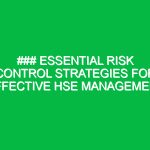Introduction
In the realm of Health, Safety, and Environment (HSE), the significance of a well-structured risk assessment plan cannot be overstated. A risk assessment plan example serves as a blueprint for identifying, evaluating, and mitigating risks that could potentially harm individuals, property, or the environment. This proactive approach is vital in fostering a culture of Safety in workplaces and ensuring compliance with legal requirements. As organizations strive for operational excellence, understanding and implementing effective risk assessment plans becomes indispensable.
This article delves into the intricacies of risk assessment plans within the HSE context, providing a comprehensive example that embodies Best Practices, methodologies, and regulatory compliance. Through a blend of theoretical insights and practical applications, we aim to equip industry professionals with the knowledge necessary to execute successful HSE strategies.
The Core Components of a Risk Assessment Plan Example
To develop an effective risk assessment plan example, it is essential to comprehend its fundamental components. These components guide organizations in systematically addressing potential Hazards. Below are the key elements:
1. Hazard Identification
The first step in any risk assessment plan is to identify potential Hazards that could pose risks. Hazards can be physical, chemical, biological, ergonomic, or psychosocial. For instance, in a manufacturing setting, hazards might include machinery malfunctions, exposure to toxic substances, or repetitive strain injuries.
A practical approach to hazard identification can involve:
- Conducting Safety audits and inspections.
- Engaging employees for their insights and experiences.
- Reviewing incident reports and historical data.
2. Risk Analysis
Once hazards have been identified, the next step is to analyze the risks associated with each hazard. This involves evaluating the likelihood of occurrence and the potential consequences. For example, while a chemical spill may be unlikely, the repercussions could be severe, warranting higher priority in risk mitigation strategies.
Risk analysis can be performed using qualitative methods, such as risk matrices, or quantitative methods, where statistical data is analyzed. A risk matrix, for example, can help categorize risks into low, medium, and high, enabling organizations to prioritize their response efforts effectively.
3. Risk Evaluation
Risk evaluation involves comparing estimated risks against predetermined risk criteria to determine their significance. This step allows organizations to make informed decisions about which risks require immediate action and which can be monitored over time.
An excellent example is in the construction industry, where risks such as falls from height must be prioritized due to their high potential for fatality. Evaluating risks ensures that resources are allocated effectively, focusing on the most critical areas.
4. Risk Control Measures
After evaluating risks, the next logical step is to implement Control Measures. These measures can include engineering controls, administrative controls, personal protective equipment (PPE), and Training programs.
For instance, if a risk assessment identifies noise exposure as a significant hazard, control measures may involve installing sound barriers, implementing job rotation, and providing employees with ear protection.
5. Monitoring and Review
Risk assessment is not a one-time event but an ongoing process. Regular monitoring and review of the risk assessment plan ensure that it remains relevant and effective. Changes in processes, equipment, or Regulations may necessitate updates to the risk assessment.
Organizations should schedule periodic reviews, conduct follow-up inspections, and encourage feedback from employees to identify new hazards or changes in existing risks.
Benefits of Implementing a Risk Assessment Plan Example
The integration of a robust risk assessment plan yields numerous Benefits for organizations operating within the HSE domain. Here are some of the most significant advantages:
1. Enhanced Safety Culture
A well-implemented risk assessment plan fosters a culture of safety within the organization. Employees become more aware of potential hazards and feel empowered to take action, leading to a proactive rather than reactive approach to safety.
2. Regulatory Compliance
Many jurisdictions require organizations to conduct risk assessments as part of their regulatory obligations. By adhering to these requirements, businesses can avoid legal penalties and maintain their reputation.
3. Reduced Operational Costs
Investing in risk assessment can lead to significant cost savings. By identifying and mitigating risks before they result in incidents, organizations can reduce the likelihood of accidents, associated costs, and insurance premiums.
4. Improved Employee Morale
When employees see that their safety is a priority, it enhances their morale and productivity. A safe work environment leads to job satisfaction and can reduce turnover rates.
Best Practices for Developing an Effective Risk Assessment Plan Example
To ensure the success of a risk assessment plan, organizations should adhere to Best Practices tailored to the HSE context:
1. Involve Employees
Engaging employees at all levels in the risk assessment process can provide valuable insights and foster a sense of ownership. Employees often have firsthand knowledge of the risks they face in their roles and can contribute significantly to identifying hazards.
2. Use a Structured Approach
Adopting a structured framework, such as the Plan-Do-Check-Act (PDCA) cycle, can enhance the effectiveness of risk assessments. This approach promotes continuous improvement by ensuring that organizations revisit and refine their risk assessments regularly.
3. Document Everything
Thorough documentation is essential for accountability and compliance. All findings, actions taken, and reviews should be documented meticulously. This documentation serves as a reference point and can be invaluable during audits or inspections.
4. Provide Training
Training employees on the risk assessment process and the importance of safety can reinforce the organization’s commitment to HSE principles. Training should include hazard recognition, risk assessment Procedures, and the use of control measures.
5. Leverage Technology
In today’s digital age, utilizing technology can streamline the risk assessment process. Software applications can assist in tracking risks, managing documentation, and facilitating communication among team members.
Real-Life Example: Risk Assessment in the Oil and Gas Industry
To illustrate the application of a risk assessment plan example, let’s consider the oil and gas industry. This sector is fraught with risks, including explosions, chemical spills, and environmental degradation.
In a hypothetical scenario, an oil company conducts a comprehensive risk assessment of its drilling operations.
- Hazard Identification: The team identifies hazards such as equipment failure, human error, and environmental factors like extreme weather.
- Risk Analysis: They analyze the likelihood of each hazard occurring and the potential impact on workers and the environment.
- Risk Evaluation: High-risk areas, such as equipment failure, are prioritized for immediate intervention.
- Control Measures: The company implements regular Maintenance schedules, provides extensive employee training, and uses advanced monitoring technology.
- Monitoring and Review: The risk assessment is reviewed quarterly to incorporate any changes in operations or regulations.
This structured approach not only enhances safety but also ensures compliance with industry regulations, showcasing the importance of a well-designed risk assessment plan.
Regulations and Standards in Risk Assessment
Numerous regulations and standards guide the development and implementation of risk assessments within the HSE framework. Familiarizing oneself with these guidelines is essential for effective risk management:
1. Occupational Safety and Health Administration (OSHA)
In the United States, osha mandates that employers provide a safe working environment. Their guidelines emphasize the need for regular risk assessments and the identification of hazards.
2. International Organization for Standardization (ISO)
ISO 45001 is a standard for Occupational Health and safety management systems. It encourages organizations to establish a proactive risk assessment process to improve safety performance.
3. Environmental Protection Agency (EPA)
The EPA provides regulations regarding environmental risks. Organizations must assess and mitigate risks that could harm the environment, in addition to focusing on Workplace Safety.
Conclusion
A well-structured risk assessment plan example is pivotal for achieving success in the HSE domain. By identifying hazards, analyzing risks, implementing control measures, and continuously monitoring their effectiveness, organizations can create safer working environments, ensure regulatory compliance, and enhance overall operational efficiency.
The importance of risk assessment extends beyond mere compliance—it fosters a culture of safety, improves employee morale, and can lead to significant cost savings. As industries face evolving challenges and regulatory landscapes, the need for effective risk assessment plans becomes ever more critical.
In closing, organizations are encouraged to invest time and resources into developing and refining their risk assessment plans. The journey towards HSE excellence is ongoing, but with a solid risk assessment framework in place, the path to success becomes clearer and more achievable.


